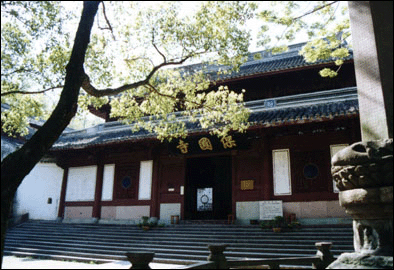|

Baoguo Temple is a thousand-year-old renowned temple and one of the first cultural relic sites designated to be specially preserved in China. It is situated at the foot of Mount Feishilin in Jiangbei District of Ningbo City, thirteen kilometers away from the downtown. The Grand Hall in Baoguo Temple is one of the oldest and best-preserved wooden structures in South Yangtze region of China, invaluable to the nation's architectural studies.
Baoguo Temple has a long history. As historical records go, in the Guangwu reign of the East Han Dynasty (25-220), Zhang Qifang, head of the secretariat, son of Dashing General Zhang Yi, retired here after quitting officialdom. He transformed his hut into a temple and named it Linshan Temple, also known as "Dashing General Temple". It was later ruined, then rebuilt, destroyed again in the Huichang Reign of the Tang Dynasty when Buddhism was denounced as heretic. In 880 of the Tang Dynasty, Monk Kegong of Guoning Temple in Mingzhouguo (the present Ningbo) was sent to Chang'an, to entreat Tang Xizong, the then Emperor of the Tang Dynasty, to have Linshan Temple restored. While in Chang'an, he lectured on Buddhist Scriptures in the Hongfu Temple, thus greatly boosting Buddhism. Tremendously pleased, the emperor thought the restoration of Baoguo Temple was a great help in strengthening China, and thus a great tribute to it. Therefore, the emperor blessed him with a stele on which were written two large Chinese characters "Bao Guo" (Protecting the Country). Linshan Temple was then renamed Baoguo Temple and kept the appellation ever since. For a time it was known as Jingjin Academy (the stele of "Jingjin" is today still preserved in the Grand Hall). Having gone through repeated rise and fall, the temple as it stands today is largely composed of buildings erected in the Ming and Qing Dynasties or in the Period of the Republic of China except the main hall, which was erected in the Song Dynasty. The temple now covers an area of 13,280 square meters and a floor space of 6,000 square meters, with a gardening area of 28.8 acres.
The most magnificent building in the temple is the Grand Hall, known as the "Beamless Hall". The present hall is constructed in 1013 in the North Song Dynasty. The Grand Hall of Baoguo Temple has great values for historians, artists and scientists. The hall, made of wood, is exquisite in structure and unique in style. It is rectangle in dimension, three rooms in width and three rooms in length. Its roof is firmly fixed by means of skillful cohesion of components through sophisticated traditional Chinese architectural technology. Eight large upright beams in the hall, slightly inclined towards the middle, bear the total weight of 50 tons of the building. On the ceiling just to the upper front of the hall are three well-like hollows cleverly connected with the whole frame. They somewhat conceal the skeleton-like beams from the visitors to the hall, which is why it is called "A Beamless Hall". But as a matter of fact, "beamless" should be "countless". People mistakenly claimed the temple's grand hall "Beamless Hall" deceived by its real name--"The Hall of Countless Longevity Buddha". Through a funny mistake, it has been known as "Beamless Hall" ever since. The hall's unique style fully embodies the wisdom and creativeness of the ancient Chinese working people. The grandeur of the hall can be seen from the following ancient poetical lines: "Hidden deep among dark mountains stands the grand archaic palace hall", "With its artful arch-like structures high and towering; the palace's glory will go on forever in people's mind".
There is one more incredible thing about this hall: no birds nestle here, no spiders weave webs here, no insects or ants crawl here, nor can you find much dust or dirt here. For many years, many architecture and forestry experts carried studies here, yet no one gave any satisfactory explanation about this mystery. The mystery remained unsolved until in 1975 when the hall went through innovations and some carpenters found there was a strong pungently fragrant smell given off from the wood. Scientific studies of the wood have revealed that the wood is of some Chinese junipers, which gives off an offensively fragrant smell which drives away birds and insects. The absence of any dust throughout the hall can be accounted for by the fact that the air in the hall is in constant motion because of the revolving wind caused by the exquisite structure of the hall. |